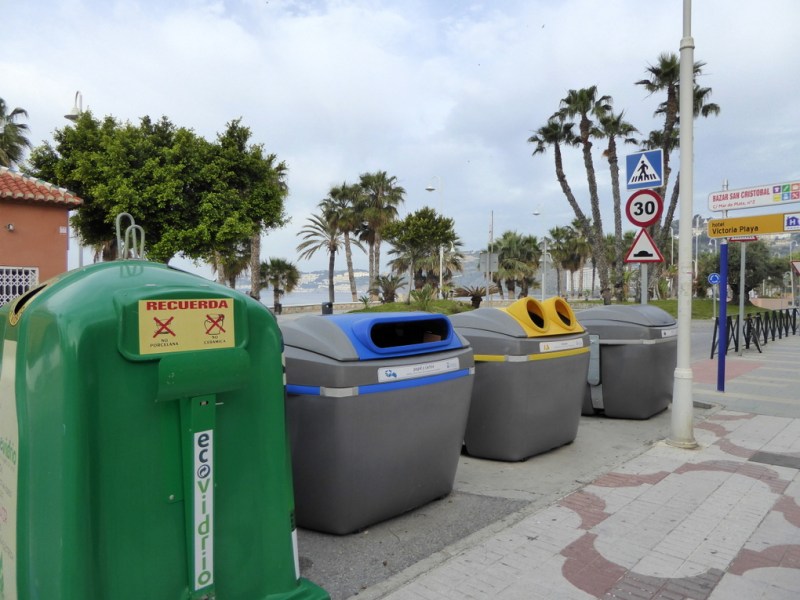Ready, Set, Containerize: City Moves Ahead with ‘Open Streets: Garbage’ Plan


Wait a second — wasn’t the point to get garbage off the sidewalks?
A long-awaited city program to allow building owners to install commercial trash containers in parking spaces has a loophole that won’t be viewed too kindly by long-suffering pedestrians: it allows business improvement districts and other landowners to apply to put trash bins on the sidewalk.
Guidelines for the “Clean Curbs” program were released on Thursday and, for the most part, conform to what Streetsblog reported exclusively back in March: the departments of Sanitation and Transportation are collaborating to create rules for a first in New York City: Allowing the estimated 350,000 commercial building owners to store their garbage in sealed containers on the street instead of how they currently do it now: piling up huge, leaking plastic bags on sidewalks all over town every afternoon, where they present a health and safety issue for pedestrians (who already don’t have enough room).
It’s the latest effort by the de Blasio administration to claw back some of the estimated three million curbside spaces that city drivers believe is their space to store their privately owned vehicles (almost entirely for free) or operate the pollution-spewing devices with virtually no restrictions. Earlier this year, Mayor de Blasio created an open streets program to reclaim roughly 70 miles of roadway from drivers in support of walkers and cyclists, which was soon followed by the “Open Streets: Restaurant” version, which allows restaurants to set up dining areas in curbside spaces.

“Clean Curbs” is a bit like “Open Streets: Garbage” in that the city is hoping building owners and business groups set out Euro-styled trash containers in the street. Pedestrian advocates will likely be concerned about the ability of building owners to use the sidewalk, but it appears that the city will discourage that.
“Proposals for containers on the sidewalk will be accepted if accompanied by a pedestrian level of service analysis for the proposed location(s),” the guidelines state. “Proposals for containers in the curb lane portion of the roadway will have preference.”
In a subsequent interview with Streetsblog, the DSNY emphasized the need to protect pedestrians.
“For a sidewalk location to be eligible, it must be an especially wide one — even with the container, there must still be eight to 10 feet of passable sidewalk width left,” the agency said in a statement. The agency said the sidewalk option is crucial for areas such as the “Lower East Side/Chinatown Rat Mitigation Zone,” where streets are very wide, but residents consistently demand solutions for the rodent problems associated with commercial and restaurant trash.
When the “Clean Curbs” announcement was originally reported by Streetsblog in March, commissioners of both agencies hailed it:
“City pedestrians navigate around piles of trash and recycling that take up significant sidewalk space,” said then-Sanitation Commissioner Kathryn Garcia, who has resigned to run for mayor. “It is time to make smarter, more efficient choices when it comes to the way New Yorkers set out refuse and recycling for collection in the public right of way. Thursday’s announcement is the first step in that direction.”
Department of Transportation Commissioner Polly Trottenberg, who has also resigned (not to run for mayor!), said containerizing trash “will help make New York’s bustling sidewalks cleaner, more accessible, and more enjoyable for residents and tourists alike.”
It is unclear what the commercial trash containers will look like, beyond the basic rules posed by the city:
- Applicants are encouraged to incorporate street furniture elements to the container design and site, such as bike parking and seating.
- On-street containers “shall extend no more than eight feet from the curb into the roadway” (including a six-inch gap “to allow for drainage”). On narrower streets, DOT may only allow a six-foot-wide container to ensure emergency vehicle access. They can’t be longer than 20 feet, taller than five feet, and wider than eight feet.
- Sidewalk containers “must maintain a minimum of eight feet of clear path of travel for pedestrians on the sidewalk or half of the sidewalk width, whichever is greater.” These containers can’t be longer than 10 feet, taller than five feet, and wider than five feet.
- On some sidewalks, DOT “may require a 10-foot clear path of travel for pedestrians on the sidewalk in order to prevent pedestrian pinch points and overcrowding.”
- No advertising is allowed to be displayed on the container.
DSNY Clean Curbs Requirements by Gersh Kuntzman on Scribd





